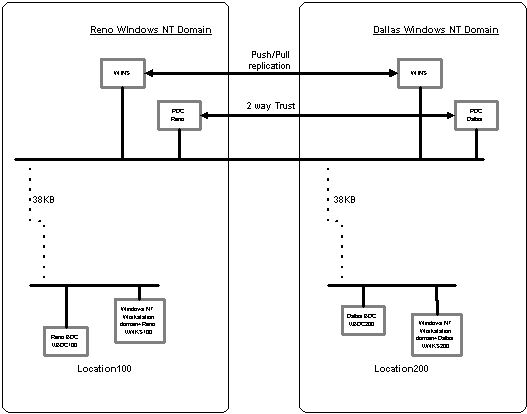
Most corporate domains designs fall into one of the following models, the Single domain model, the Master domain model, the Multiple Master domain model or the Complete Trust domain model. For more information on each of these models refer to the Windows NT Adminstration guide.
In this section we are going to discuss two of these models, the Complete Trust model and the Multiple Master model. We will look at the models before DNS and the models after DNS. Hopefully, this will give you an understanding of how to implement DNS within your own environment.
Let's start with the following domain design (without DNS) and determine the best approach to a DNS design architecture. The following is an example of a Complete Trust domain model. There are 2 domains "Reno" and "Dallas." Let's assume the following:

When designing a solution it is important to consider the traffic flow of "session setup" and "logon validation." You never want to design a solution that would keep a client from contacting its local server if the link between the remote location and its data-center was lost.
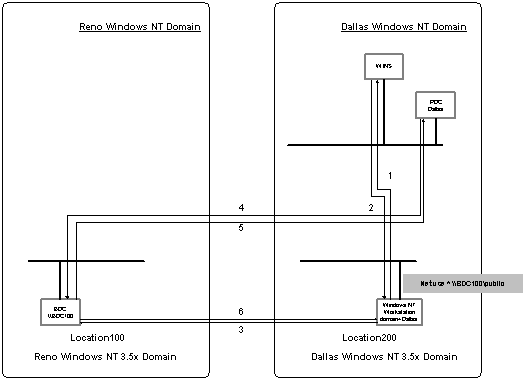
In our example logon validation will occur locally between the clients and the local servers. Session setup and name resolution to the "local" servers will also occur locally because the clients are set up as Mnode TCPIP clients. Session setup and name resolution between a client in one location and a server in another remote location will take a much different path and include both the WINS server in the data-center and the clients domain PDC. In our example (note that in our example some of the devices were removed to make the diagram easier to view), the Windows NT Workstation-based machine in the Dallas domain location 200 is connecting to the server \\BDC100 in the Reno domain location 100. The client first contacts the WINS server in its data-center to get the IP address of the \\BDC100 server (1 and 2). It then tries to establish a session to the \\BDC100 server (3). The \\BDC100 server in turn uses its secure session to the clients PDC for "pass through authentication" purposes (4 and 5). If the security is verified, the client is allowed to establish the session and proceed (6). In this example, there are three physical points of failure, the link between Location 200 and the Dallas data-center, the link between the Dallas data-center and the Reno data-center, and the link between Location 100 and the Reno data-center.
Now that you understand the current architecture, how would you design a Windows NT 4.0 DNS implementation?
Here is a possible solution. There are four zones, four domains (com, acme.com, reno.acme.com and dallas.acme.com) and a DNS server in each remote location in the following design.
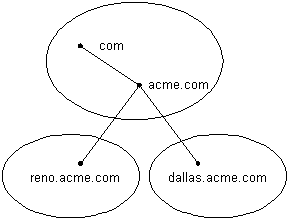
The following are facts about the design:
With this design in place a client from a remote location can now establish a session via HOST name rather than NetBIOS name. For example, instead of typing
Net use * \\BDC100\public
they can type
Net use * \\BDC100.reno.acme.com\public
Let's follow the path of traffic if the client chooses to connect via the HOST name mechanism,
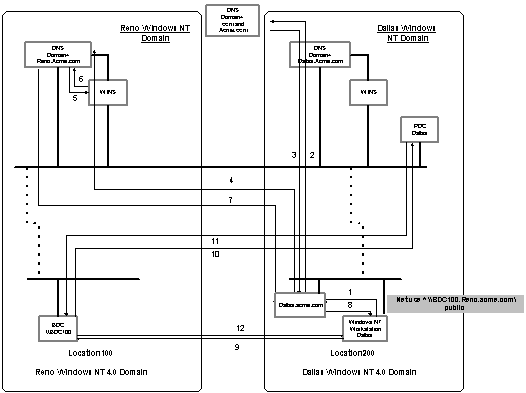
The client contacts its local DNS server with a recursive query (1). The dallas.acme.com cache-only DNS server checks its local memory cache, if the IP address for BDC100.reno.acme.com is not cached, the dallas.acme.com DNS server sends an iterative query to the ROOT server, then to "COM," then to "DOMAIN.COM" (that is Acme.com) (2). The acme.com server will respond back (3) and tell dallas.acme.com to contact reno.acme.com (4). When dallas.acme.com contacts reno.acme.com, the DNS server reno.acme.com will check the WINS server (5) defined in its WINS record (6) and the reno.acme.com responds with the IP address (7) and the directed name query and session setup can continue (8,9,10,11 and 12). If the IP addresses were not cached, it would take eight frames for IP address to name resolution (compared to two frames in the WINS design).
|
|
If the dallas.acme.com DNS server was configured with a "Forwarder" the request to acme.com would have still been iterative. However, if the dallas.acme.com DNS server was configured as a "Slave" server the request to acme.com would have been recursive. |
Once Dynamic DNS and Enhanced Directory Services become a reality, the WINS servers in this enterprise can be removed and NetBIOS can be turned off. From this point on DNS will be used as the index into the directory to find machine objects such as computers and domain controllers.
In the following section we are going to go through a very simple "well architected" Windows NT 4.0 Multiple Master domain model and show how to implement DNS within that environment for a safe migration to future versions of Windows NT.
Here is the typical Multiple Master layout with two master domains and six resource domains:
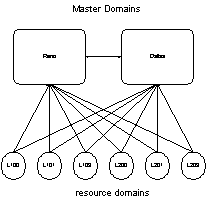
Let's use the "Reno" and "Dallas" domain structure and assume the following:
The following figure shows the current layout:
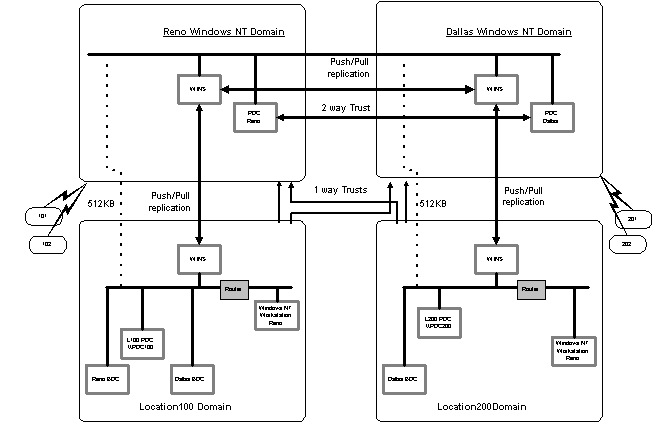
Let's look at the traffic flow for logon validation and session setup name resolution. In most Multiple Master domain scenarios, the client Windows NT-based machine accounts exist in the resource domain and the user logs onto the Master domain. All logon validation will be done locally within the site. A Windows NT Workstation-based client upon bootup queries the local WINS server for a list of BDCs (via name query for DOMAIN <1C>). The WINS server will respond with a list of up to 25 BDCs (the list contains the PDC and all of the BDCs for the master domain that registered with it, as well as others that were replicated to it). The client then sends a request to each server on the list and uses the first server to respond (which normally will be the local master domain BDC) as its server that it sets up a secure channel with and uses to do logon validation.
Remote session setup from a client running Windows NT client in a resource domain to a server in another resource domain occurs as follows as is shown in the next diagram.
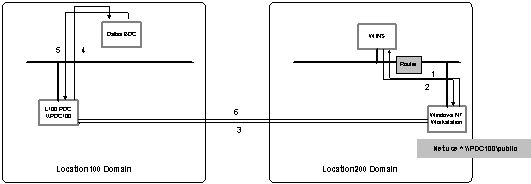
The client running Windows NT Workstation will query the WINS server for the address for the server in the domain it wants to contact (1). The WINS server will reply with the address (2) because it was replicated to it previously. The Windows NT-based workstation will then contact the server directly (3). That server will see that the session setup request is from a user in a trusted master domain and use its secure channel to a trusted domain BDC or PDC to verify the credentials (5) and then the server will either allow the client to connect or reject the request (6).
Now that you understand the current architecture, how would you design a Windows NT 4.0 DNS implementation? The first thing we have to determine is how to structure the DNS domains. We know that for future migration purposes DNS domains should equal Windows NT 4.0 domains. The first and most important question is now answered—that is, how many domains do I need? The answer is, one for each Windows NT domain—ten.
The second question is, how should the domain names map? For example, should we have L100.reno.acme.com or L100.acme.com? In any design it's important to keep it simple! That means in our case, keep the name as short as possible. There is another part to this second question and that is, what DNS domain should the clients and servers be part of? In the Multiple Master scenario, the logical solution is to put all workstations within a DNS domain called L100.Acme.Com and L200.Acme.Com and so on, then put all servers within a domain called Reno.Acme.Com and Dallas.Acme.Com (this may require changes to each clients TCPIP configuration). This will allow for easy migration to both Dynamic DNS and Enhanced Directory Services.
The third question is, how many servers will we need to support this? There will be 10 DNS domains (the eight expected + acme.com and com) and eight DNS servers, just like there are eight Windows NT domains and domain controllers (PDCs and BDCs). This will require that the DNS server service be running in each of the locations. The service can run on the existing PDC or BDC within the remote location assuming there is adequate capacity. The DNS servers in the locations that house the resource domains will be primaries for their Windows NT resource domain names such as L100. Acme.Com and secondaries to their respective Windows NT Master domains such as Reno.Acme.Com.
With all of this said, the DNS domain hierarchy might look something like the following:
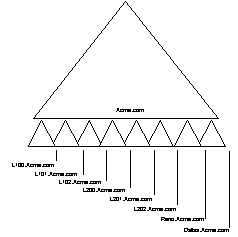
With this design in place, a client from a remote location can now establish a session via HOST name rather than NetBIOS name. For example, instead of typing
Net use * \\WKS100\public
they can type
Net use * \\WKS100.L100.acme.com\public
If the client chooses to connect via the HOST name mechanism, let's follow the path of traffic and compare it to the path via WINS (note that in our example some of the devices were removed to make the diagram easier to view).
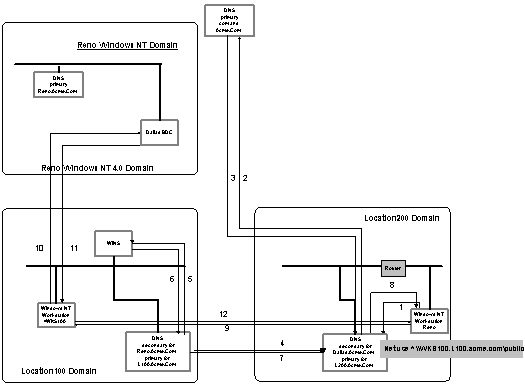
The client contacts its local DNS server with a recursive query (1) for the "NT workstation.domain." The local DNS server checks its local memory cache, and if the IP address for WKS100.L100.acme.com is not cached, the local DNS server sends an iterative query to the ROOT server, then to "COM," then to "DOMAIN.COM" (that is acme.com) (2). The acme.com server will respond (3) back and tell the local DNS server to contact L100.acme.com (4). L100.acme.com will check the WINS server (5 and 6) (the DNS server asks itself, "I should have the IP address for host WKS100.L100.acme.com because I am authoritative for domain L100.acme.com, but I don't, so check WINS") defined in its WINS record and responds with the IP address (8) and the directed name query and session setup can continue (9,10,11,12). If the IP addresses were not cached, it would take eight frames for IP address to name resolution (compared to two frames in the WINS design).
|
|
Both zones on the DNS server within the remote location should point to the same local WINS server. |
|
|
The local DNS server authoritative for reno.acme.com did not contact its local WINS server because the DNS name being asked for was not a direct child of its DNS domain reno.acme.com. It was only a direct child of a DNS server that was authoritative for L100.acme.com. |
A client from a remote location can also establish a session with a remote server via the HOST name rather than NetBIOS name. For example, instead of typing
Net use * \\PDC100\public
they can type
Net use * \\PDC100.reno.acme.com\public
If the client chooses to connect via the HOST name mechanism, let's follow the path of traffic and compare it to the path via WINS (note that in our example some of the devices were removed to make the diagram easier to view).
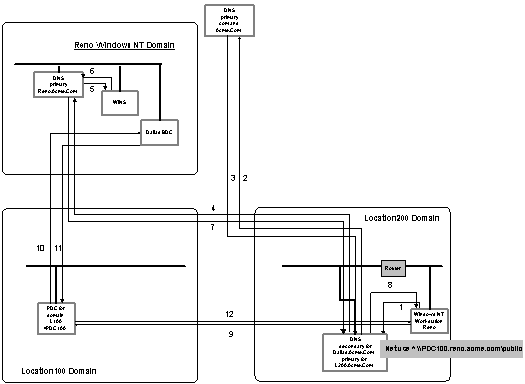
The client contacts its local DNS server with a recursive query (1) for the "NT workstation.domain." The local DNS server checks its local memory cache, and if the IP address for PDC100.reno.acme.com is not cached, the local DNS server sends an iterative query to the ROOT server, then to "COM," then to "DOMAIN.COM" (that is acme.com) (2). The acme.com server will respond (3) back and tell the local DNS server to contact reno.acme.com (4). When the local DNS server contacts reno.acme.com, the DNS reno.acme.com will check the WINS server (5 and 6) (the DNS server asks itself, "I should have the IP address for host PDC100.reno.acme.com because I am authoritative for domain Reno.acme.com, but I don't, so check WINS") defined in its WINS record and respond with the IP address (7). The local DNS then returns that address to the client (8) and the directed name query and session setup can continue (9,10,11,12). If the IP addresses were not cached it would take eight frames for IP address to name resolution (compared to two frames in the WINS design).
|
|
The local DNS server did not contact its local WINS server because the DNS name being asked for was not a direct child of a DNS domain L200.acme.com or dallas.acme.com it was only a direct child of a DNS server that was authoritative for reno.acme.com. |
Once Dynamic DNS and Enhanced Directory Services become a reality the WINS servers in this enterprise can be removed and NetBIOS can be turned off. From this point on, DNS will be used as the index into the directory to find machine objects such as computers and domain controllers.
It may seem like there are more points of failure for name resolution (eight frames via DNS versus. two frames via WINS), however with this architecture there will be less Dynamic DNS replication than there is WINS replication today and the flat 16 character NetBIOS name space will be history!